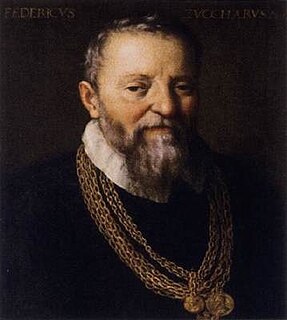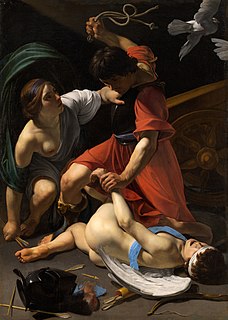Related Research Articles

Federico Zuccaro, also known as Federico Zuccari, was an Italian Mannerist painter and architect, active both in Italy and abroad.

The Caravaggisti were stylistic followers of the late 16th-century Italian Baroque painter Caravaggio. His influence on the new Baroque style that eventually emerged from Mannerism was profound. Caravaggio never established a workshop as most other painters did, and thus had no school to spread his techniques. Nor did he ever set out his underlying philosophical approach to art, the psychological realism which can only be deduced from his surviving work. But it can be seen directly or indirectly in the work of Rubens, Jusepe de Ribera, Bernini, and Rembrandt. Famous while he lived, Caravaggio himself was forgotten almost immediately after his death. Many of his paintings were reascribed to his followers, such as The Taking of Christ, which was attributed to the Dutch painter Gerrit van Honthorst until 1990. It was only in the 20th century that his importance to the development of Western art was rediscovered. In the 1920s Roberto Longhi once more placed him in the European tradition: "Ribera, Vermeer, La Tour and Rembrandt could never have existed without him. And the art of Delacroix, Courbet and Manet would have been utterly different". The influential Bernard Berenson stated: "With the exception of Michelangelo, no other Italian painter exercised so great an influence."

Alexander Cooper was an English Baroque miniature painter.

Cosimo Rosselli was an Italian painter of the Quattrocento, active mainly in his birthplace of Florence, but also in Pisa earlier in his career and in 1481–82 in the Sistine Chapel in Rome, where he painted some of the large frescoes on the side walls.

The Affecter was an Attic black-figure vase painter, active in Athens around 550 to 530 BCE.

The Antiphon Painter was an Athenian vase painter of the early 5th century BC. He owes his name to a double Kalos inscription of Antiphon on the dinos stand in the Antique collection of Berlin. He was active between 500 and 475 BC in Athens as a painter of the red-figure style in the largest workshop of the 5th century. He learned his handicraft in the workshop of Euphronios and Onesimos. There he worked closely with them, the Kalmarer Painter and other painters.

Joseph Lycett was a portrait and miniature painter, active in Australia. Transported to Australia for forging banknotes, Lycett found work in the colony as a painter specialised in topographical views of the major towns of Australia, and some of its more dramatic landscapes.
Events from the year 1755 in art.
Events from the year 1530 in art.

The Providence Painter is the conventional name given to a painter of the Attic red-figure style. He was active around 470 BC.

The Dinos Painter was an Attic red-figure vase painter who was active during the second half of the 5th century BC. The Dinos Painter stood in the tradition of the Kleophon Painter, but was less serious. One or few figures are depicted as the centre of an event; the frieze-like depiction of the course of the event seen in earlier styles is absent. His paintings initiate the "Rich Style" of the following generation; he already uses an increased amount of white to stress details. The technique of using white to depict Eros and furniture is an innovation of the Dinos Painter; a generation later it formed part of the standard repertoire.

The Foundry Painter was an ancient Greek Attic red-figure vase painter of the Late Archaic period. His real name is unknown; the conventional name is derived from his most famous work, the Berlin Foundry Cup.
The Diosphos Painter was an Athenian Attic black-figure vase painter thought to have been active from 500–475 BCE, many of whose surviving works are on lekythoi.
Events from the year 1957 in Denmark.

The Cerameicus Painter was one of the first Attic black-figure vase painters. He was active around 600 BC.

The Anagyros Painter or Anagyrus Painter was a vase painter of the early Attic black-figure style, active in the first quarter of the 6th century BC. His works have only been found in inland Attica, mainly at Vari, but not in Athens itself. It is thus assumed that he was not active within the city and only produced for a very limited rural area. In contrast to many of his contemporaries, he did not paint lekanes but various large formats, such as amphorae, kantharoi, chalices, oinochoai and plates.

Pamphaios was an Attic potter active around the end of the 6th century BC. Pamphaios was the successor of Nikosthenes in that artist's workshop, and thus took over from one of the most influential and creative potters of antiquity. He probably took over the workshop before 510 BC and continued the tradition of his predecessor by producing typical shapes the latter had developed, such as the Nikosthenic amphora, the Nikosthenic pyxis or the Chalkidian style cup. At times, he developed these shapes further. Unlike Nikostehenes, Pamphaios favoured painters of the red-figure style, which was at the time replacing the previously dominant technique of black-figure vase painting. He also continued to employ many of the painters that had worked for Nikosthenes, such as Oltos, Epiktetos and the Nikosthenes Painter.

The Rycroft Painter was an Attic late black-figure vase painter, active in the final decade of the sixth century BC. His real name is not known.

The Madrid Painter was an Attic black-figure vase painter active during the late period of the style, around 520 BC.

The Arkesilas Painter was a Laconian vase painter active around 560 BC. He is considered one of the five great vase painters of Sparta.
References
- Bryan, Michael (1889). Walter Armstrong; Robert Edmund Graves (eds.). Dictionary of Painters and Engravers, Biographical and Critical. Vol. II L-Z. London: George Bell and Sons. p. 66.